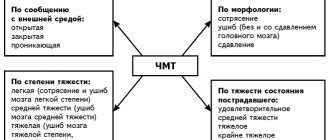Head injuries are especially dangerous because they can cause brain damage with all the ensuing consequences.
| Nature is wise, and the brain, as a vital organ, is maximally protected from damage by the skull, but its strength is very limited. Head injuries can lead to a variety of symptoms and impairments, depending on their severity. There are three head injuries of increasing severity: bruise, concussion and other traumatic brain injuries. |
First aid for head injuries
A head contusion occurs when the head hits a hard surface with relatively little force. It is characterized by the occurrence of a hematoma or “bump”; usually there is no violation of the integrity of the tissues, but damage to the skin is possible. It is necessary to apply ice or a cold compress to the site of the bruise, which should be replaced as it warms up. If there is a bleeding wound, it should be washed and disinfected, and then a clean bandage should be applied to stop the bleeding. If bleeding does not stop for more than 10-20 minutes or symptoms of a concussion are observed, you should immediately seek emergency medical help.
First aid for wounds, cuts, abrasions
In this article we will look at:
- How do you know whether to treat a wound yourself or go to a doctor?
- How to treat any wounds: from superficial abrasions and scratches to deep cuts
- What to do with foreign objects stuck in a wound?
- How to cover the wound so that the bandage does not dry out and you don’t have to tear it off “with the meat”?
- What mistakes to avoid
- What should you have in your first aid kit to successfully cope with this task?
Wound or life?
Before delving into the details of treating wounds during first aid , let's remember where this procedure ranks in terms of importance for the life of the victim in the picture of first aid.
This is important to remember because wounds, especially large and scary ones or located in “scary” places (face, groin, etc.) frighten us, and we fix our attention on them, forgetting about the person as a whole. Sometimes this natural shift in attention leads us to overlook much more serious things that do not look so scary, but threaten the victim’s life much more than a torn cheek.
A typical example of a “terrible” wound that is not life-threatening, but distracts the rescuer from the more important problems of the victim. Wound from a car seat belt.
Remember!
treat wounds during first aid only if there is no immediate threat to the life of the victim.
Namely:
- The victim is safe
The external threat has been eliminated or eliminated.
- Severe bleeding is absent or stopped.
Read about how to recognize heavy bleeding and stop it in a special article.
- The victim is breathing on his own.
It does not matter whether he is conscious or not. The main thing is that he breathes himself.
If at least one of the above problems is not solved, we do not treat wounds under any circumstances.
The wound itself is not life-threatening, and therefore has one of the very last priorities in the order of first aid.
Should you provide first aid for wounds yourself or consult a doctor?
The purpose of treating a wound when providing first aid is not to save a life, but to prevent possible unpleasant complications, the main and most likely of which is infection of the wound and the spread of infection throughout the body.
Seeking professional help is necessary or highly recommended if:
- There is a need for stitches:
- the wound is large and/or deep
the wound is on the face
- the wound is located on the bends (elbow, knee, etc.), and will not be able to heal without stitches due to the constant movement of the wound edges
- You understand that you will not be able to treat the wound efficiently:
- there is a lot of dirt and foreign particles in the wound
there are large foreign objects firmly stuck in the body
- the wound has torn edges or part of the skin is missing (there is no way to close the edges of the wound)
- A wound is the result of an animal bite or scratch.
- You may need to prescribe antibiotics
Rabies and tetanus vaccines will be needed
Self-treatment of the wound is possible and highly recommended if:
- The wound is superficial, without large foreign bodies and does not require suturing
- Any wound is terrible, but you are at a considerable distance from medicine: a dacha, a village, a hike.
If the injury is one that requires medical attention, still carry out the maximum possible treatment. This will reduce the risk of infection and inflammation, or at least delay their occurrence. Upon returning to civilization, go to an emergency room or hospital as quickly as possible for professional treatment and prescription of medications, if necessary.
First aid for injuries.
Treatment of the wound. Step by step instructions.
So, your victim is alive, his life is not in danger right now, and you have decided or are forced to treat his wound yourself. Where to start providing first aid for injuries ?
1. Wear gloves!
This will allow you:
- Do not introduce infection from your hands into the victim’s wound.
- It will keep your hands clean and eliminate the possibility of the victim’s blood getting on surrounding objects (a first aid kit, for example) and people with whom you will come into contact after providing first aid for an injury.
2. Wash and disinfect the skin around the wound.
Washing the skin around the wound from blood and dirt
How?
Take a gauze pad or any other piece of gauze (piece of bandage), moisten it with the non-alcohol antiseptic available in your first aid kit and carefully clean all the skin around the wound site.
Attention!
When providing first aid for injuries , do not use cotton wool and/or paper napkins. They disintegrate and can remain in the wound and cause inflammation later.
For what?
You need to remove coagulated and dried blood from the injury sites. This is necessary for two things:
- only on clean skin can you accurately see all the damage and assess its size and severity
- Before washing the wound, you need to remove dirt from its edges so that after washing the wound itself, dirt does not get inside from the surface of the skin again
How?
To wash dried blood from the skin, you can use any non-alcohol antiseptics.
Hydrogen peroxide works best due to its chemical properties. Its effect is difficult to overestimate when washing blood from hair; here it really has no equal.
In the absence of peroxide, you can use chlorhexidine, miramistin, octinisept, etc.
If there is absolutely nothing, use clean water: from a bottle, from a tap, drinking water from a well, etc.
Attention!
Do not use antiseptics containing alcohol: iodine, brilliant green, vodka, perfume, cologne, etc.
First of all, it is very painful. Secondly, alcohol washes blood very poorly.
3. Wash and disinfect the wound itself
How?
Fill a 5 ml syringe with a non-alcohol antiseptic, put on a needle, use your fingers to spread the edges of the wound as far as possible and rinse the wound with a stream of antiseptic.
Using a syringe allows you to:
- Rinse the wound under pressure
, which helps get rid of small and difficult to see foreign particles: sand, soil, sawdust, rotten wood, blades of grass, etc. - Use antiseptic sparingly
, which is very important in the case of
providing first aid for injuries in remote areas
If you don’t have a syringe, use gauze pads or cotton swabs soaked in antiseptic. To remove relatively large particles visible to the eye, use tweezers, the tip of nail scissors, or cotton swabs.
4. Foreign objects – remove or leave?
Remove if foreign body:
- small: pebbles, sand, sawdust, chips, fragments, etc.
- lies freely in the wound or has penetrated into the soft tissue slightly (a few millimeters) and easily comes out when trying to remove it
DO NOT remove if the foreign body:
- has significant dimensions: a large sliver, nail, splinter, etc.
- penetrated to a considerable depth
- when trying to remove the item, the object is not removed without extreme effort
How to extract
, if this is possible?
Depending on the size of the foreign body, use:
- tweezers with the narrowest possible tip and flat lips (should be in your first aid kit)
- cotton buds
- syringe needle
What if you can’t extract it?
Then we don’t remove it, we finish treating the wound and go to the doctor to have it done professionally.
Read more about first aid in the situation of “a foreign object stuck in the body” in a special article that will be published on the pages of our blog in the near future.
So, we washed the skin around the wound, the wound itself, and removed all objects from the wound that could be removed. What's next?
5. Dry the wound and all the skin around it
How?
Pat the wound and all surrounding skin dry using gauze pads or a piece of gauze. Leave for a few minutes to evaporate the last traces of moisture.
For what?
Excessive fluid in the wound increases the risk of infection.
Moisture on the skin around the wound will not allow you to cover the wound with a plaster or post-operative bandage; they simply will not stick.
6. Treat the edges of the wound with a “colored” skin antiseptic.
How?
Apply a generous amount of antiseptic to a cotton swab or gauze pad and gently apply it to the skin around the wound in a continuous layer of at least 2 cm. Let it dry.
For what?
Disinfection is an essential part of first aid for wounds . The application of these drugs reliably disinfects the skin around the wound and does not allow bacteria to re-enter the wound from the surface of the skin, which reduces the risk of infection.
How?
It is better to use the iodine-containing antiseptic Betadine. Unlike an alcohol solution of iodine, it does not burn the wound, even if it gets into it. At the same time, it has exactly the same “destructive force”.
No Betadine? Classic alcohol iodine and brilliant green are also suitable. But be very careful not to pour them into the wound, it will be very painful for the victim.
7. Close the edges of the wound (only if necessary)
This can be done using special adhesive strips for closing the edges of the wound (sold at the pharmacy) or using narrow strips of an ordinary rolled adhesive plaster.
Read more about how and in what cases to do this in a separate article (follow our publications).
8. Cover the wound with a bandage
How?
It is best to use a modern dressing for this purpose, the so-called postoperative dressings.
They:
- reliably isolate the wound from the external environment
- they breathe, the wound under them does not get wet
- a special pad on the inner surface absorbs all the liquids that flow from the wound, allowing the wound to be as dry as possible, which is very important for reducing the risk of infection and rapid healing
- the bandage never dries to the wound, it is easy to remove and there is no need to tear it away from the wound while the victim screams
If there is no post-operative dressing, but you have gauze pads or a bandage + a roll of adhesive tape, then you can “classically” close the wound with such a homemade design
Wound-adhesive “classic”, model 1
Or apply a classic bandage of gauze and bandage.
“Classic” sticking to the wound, model 2
But keep in mind that subsequently such bandages (after just a day) will have to be soaked for a long time and tediously so as not to be torn off from the wound while the victim screams. At the same time, soaking (can take up to half an hour!) does not guarantee that you will avoid tearing off the bandage “with meat”, which obviously will not benefit the victim.
Therefore, I highly recommend that you stock up on modern postoperative dressings in advance to provide correct first aid for injuries . They are not difficult to buy and they cost quite reasonable money.
That's it, wound treatment is finished!
Treatment of the wound is complete! What's next?
If you decide not to see a doctor (for any reason), then you should:
- do dressings once a day: remove the bandage, if necessary, re-wash the wound with an antiseptic, treat the edges with Betadine and apply a new bandage
- at the first signs of inflammation: redness around the wound, cloudy liquid or pus, unpleasant odor - consult a doctor immediately!!!
- Dressings can be stopped as soon as the wound has become covered with a crust, no fluids are released from it, and there are no signs of inflammation on the skin around the wound
If you decide to see a doctor
, then he will explain all further steps to you. Ask him to write down his recommendations in detail, or write them down yourself.
Important Reminder
Providing first aid for wounds is not difficult; any person can master this skill at a level sufficient to successfully treat most wounds encountered in everyday life.
Remember: even if you are a super guru in this matter, do not focus on the wound and its treatment. First of all, focus on the person as a whole, his general condition and well-being. Proceed with wound treatment only if there are no other important tasks to help the person.
Conclusion and practical recommendations
Any knowledge has value only when it changes a person’s life for the better.
Now you know everything about providing first aid for injuries.
Increased confidence and willingness to act.
To maximize it:
- Read the article about dealing with heavy bleeding if you haven't read it yet. You will have a complete picture on the topic of wounds and bleeding, which will allow you to accurately recognize the type of bleeding and decide what kind of help to provide: the one described in this article or another.
- Collect home, country and other first aid kits you need so that you always have everything you need at hand, and not improvise using improvised means.
To assemble a first aid kit, you can use our video course “Do-It-Yourself First Aid Kit,” which is essentially the simplest step-by-step instructions for assembling any first aid kit to suit your individual needs and allows you to completely close this issue in just two hours.
You can view its contents here
Complete your preparation and feel calm and confident.
I wish that the knowledge gained today will never be needed!
Agree that it is better to be prepared and never use the acquired skills and knowledge than to be unprepared and find yourself in a situation where you will need them.
See you at the training and on the pages of our blog!
Compiled by Artyom Kharchikov
If you liked the material, give it a like! Let more people be able to familiarize themselves with it, maybe it will save someone’s life.
First aid for concussion
A concussion usually occurs as a result of a severe blow to the head or head. If you are not careful, you can miss it, considering it a simple bruise. It is important to remember the main signs of a concussion:
- an attack of nausea and vomiting shortly after the injury;
- a certain increase in breathing and pulse with their rapid recovery;
- the occurrence of headaches, dizziness;
- pain when moving the eyes, tinnitus;
- excessive pallor, or, conversely, blood flow to the face, excessive sweating;
- weakness, sleep disturbances;
- various disturbances of consciousness or its complete loss.
With a concussion, in some cases, disruption of the respiratory and cardiac systems may occur, so in such a situation you need to be prepared to perform artificial respiration and cardiac massage. A person with a suspected concussion should not be disturbed; it is better to ensure that he is in a horizontal position with his head slightly elevated. If you observe the symptoms described above, you should not let the situation take its course; you should seek professional medical help.
Clinical course of the pathology
More often than others, with traumatic brain injuries, a concussion occurs without macrostructural lesions. Brain damage at the cellular level is reversible and treatable. The main symptoms of a concussion are loss of consciousness for a short time, nausea and vomiting, dizziness, headaches, double vision, sweating, memory loss. From a neurological point of view, there is a violation of symmetry in tendon reflexes, small-scale nystagmus, which under normal conditions disappears a week after the injury. If the victim undergoes a computer or magnetic resonance imaging scan, they will not reveal any pathologies.
With traumatic brain injuries, brain contusion can occur. This pathology leads to hemorrhages and destruction (gross macrostructural disorders) in the brain, accompanied by subarachnoid hemorrhage. Often a brain contusion is accompanied by a fracture of the skull bones. All this together can lead to swelling of the brain.
Manifestations of brain contusion by severity:
- Mild degree - the patient’s loss of consciousness can last up to 20 minutes, after which dizziness, vomiting and nausea, headaches, anterograde or retrograde amnesia occur. Vital functions remain unchanged; cardiovascular changes in the form of hypertension or bradycardia may occur. Neurological symptoms include pyramidal insufficiency, clonic nystagmus, and slight anisocoria.
- In the middle stage, the patient’s unconscious state lasts for several hours, after which severe memory loss occurs, repeated vomiting occurs, and mental health is impaired. Vital functions are impaired, persistent bradycardia, tachypnea with preservation of airway patency, hypertension. From a neurological point of view, nystagmus, imbalance in tendon reflexes and muscle tone, and various meningeal signs are observed. Focal manifestations in the form of ocular and pupillary disorders, changes in speech, and paresis of the limbs are also obvious.
- In severe cases, the patient falls into a coma, which, if not fatal, can last several weeks. Severe violations of vital functions pose a threat to life. The movements of the eyeballs are floating, the rhythm and frequency of breathing are disturbed, bilateral miosis or mydriasis, and convulsions occur. With such traumatic brain injuries, there are fractures of the skull bones in combination with massive subarachnoid hemorrhage.
Compression of the brain substance may occur due to intracranial hematomas that form above or below the soft membrane.
Clinically, compression can manifest itself in the same way as a bruise, but it has a very dangerous consequence. After the victim returns to consciousness, he usually feels better, but this does not last long, until the intracranial hematoma grows in size and begins to compress the brain. After this, the person falls into a coma again, and the prognosis for this state is rarely satisfactory. The functioning of the respiratory and vascular centers is disrupted.
First aid for other traumatic brain injuries
There are traumatic brain injuries of various degrees of severity, closed and open forms. Skull fractures and conditions caused by serious incidents, such as a traffic accident or a fall from a great height, require an immediate call to an ambulance. Before her arrival, it is necessary to provide the victim with a horizontal position and immobilize him. If a person is unconscious, it is necessary to lay him on his side to prevent the tongue from sinking. If breathing or heart function is impaired, artificial respiration or cardiac massage must be performed immediately. In case of an open head injury, it is strictly forbidden to touch or remove fragments protruding from the wound; the only thing that can be done before the doctors arrive is to treat the skin around the wound with a disinfectant and apply a sterile bandage.
Symptoms of brain contusion
Symptoms of a mild injury
Short-term fainting (up to several minutes), slight headache, hematoma when subcutaneous vessels are damaged, darkening of the eyes, drowsiness. The condition recovers on its own in a short time.
Moderate
Intense headache, vomiting, speech disturbance (slowness and unclearness), confusion, slow reactions, inability to move the arm and leg on one side normally. Often – quite prolonged fainting (up to 2-4 hours).
Symptoms of severe brain contusion
Quite a long loss of consciousness up to coma. Trouble breathing, swallowing, speech. Memory loss. The pupils are different from each other.
Others
When the bones of the skull are fractured, nosebleeds begin.
A bruise of exclusively soft tissues of the head is characterized by a hematoma at the site of impact and does not pose a serious danger. When palpated, there is a lump (due to hemorrhage in the tissue and swelling due to the release of plasma into the tissue) and pain at the site of impact. Sometimes there are minor abrasions.
Severity
- Mild degree.
A mild brain contusion has many similar symptoms to a concussion. Only with the help of computed tomography (CT) can minor damage to the brain substance be detected. After an injury, the victim loses consciousness for a short time, and when he comes to, he has amnesia: he does not remember the short period of time before the injury and the very moment of its receipt.
He also has the following symptoms:
- nausea and vomiting;
- dizziness;
- impaired coordination of movements;
- headache;
- minor heartbeat disturbance, etc.
- Average degree.
A moderate brain contusion is characterized by an intensification of previous symptoms, and the victim also has severe neurological symptoms, and minor mental disorders may be observed.
- Severe degree.
A severe brain contusion is, as a rule, an open head injury, when not only the meninges are injured, but also the brain tissue itself. This is often a complex diagnosis that combines several injuries.
If the injury is severe, the victim may remain unconscious for up to several weeks and subsequently fall into a coma.
He also exhibits the following symptoms.
- high blood pressure;
- involuntary urination or bowel movements;
- partial or complete paralysis of the body;
- high body temperature;
- mental disorders;
- epileptic seizures, etc.
Recommendations and appointments
Severe bruises that are accompanied by loss of consciousness, nausea and vomiting may indicate brain damage. In this case, it is necessary to ensure rest for the victim and immediately consult a doctor.
Patients with such symptoms should never walk, especially on their own, as an attack of dizziness can cause a second fall and more serious injury. It is clear that this could make the situation even worse.
Often, bruises, even without signs of open skin damage, can be accompanied by injury to other organs located directly in the facial part of the head.
For example, this could be a bruise of the nose, in which there is a possibility of damage to the nasal septum. Such defects need to be corrected only surgically. If an injury to the nasal septum is left to chance and adequate treatment is not provided, it may heal incorrectly, which will cause difficulty in nasal breathing, etc.
A fairly complex concomitant injury is a fracture of the skull vault. This injury is difficult to determine and sometimes can only be detected using an x-ray. Fractures of the cranial bones are very serious injuries and require immediate transport of the patient to a medical facility.
If we are talking about a bruise of the soft tissues of the head, then treatment, as a rule, is conservative. In case of formation of hematomas that are too large, it is advisable to puncture them using a thick needle through which the blood is suctioned. This procedure ends with the application of a sterile pressure bandage.
In general terms, after diagnosis, the patient’s behavior can be characterized as follows:
- ensuring complete rest, especially during the first few days after injury;
- Impeccable adherence to all recommendations of the attending physician and use of all prescribed remedies;
- refusal or limitation of serious physical activity for some time after injury;
- maintaining a correct daily routine, especially if you have dealt with a concussion, which involves long walks in the fresh air, minimal time spent watching TV or at the computer.
Classification
There are several types of TBI:
- A concussion is an injury that can lead to immediate loss of consciousness or changes in consciousness over several minutes or hours.
- A skull fracture is a violation of the integrity of bones, which can be of several types: linear or without displacement of fragments; depressed - sometimes require surgical intervention; diastolic - pass along the seams between the bones, typical for children and newborns. Separately, there is a basilar fracture at the base of the skull, which is considered the most dangerous. The symptom is the appearance of a hematoma around the eyes and behind the ear. Fluid leaking from the nose and ears indicates a rupture of the membranes of the brain. Patients require hospitalization.
- Intracranial hematoma is an accumulation of blood clots in the tissues or between the membranes of the brain. Depending on the location, there are several types of hematomas. Epidural - over the dura mater due to rupture of the middle meningeal artery during a skull fracture. Subdural - formed under the skull and under the dura mater, but do not touch the brain tissue. Associated with rupture of the veins that collect blood. An intracerebral hematoma or contusion is a contusion of the brain accompanied by bleeding and swelling. Intraparenchymal bleeding inside the brain tissue sometimes occurs spontaneously without a traumatic factor.
- Diffuse axonal injury - usually associated with shaking the brain back and forth, for example, as a result of a car accident or fall.
The damage can be mild, such as after a concussion, or severe, as with diffuse axonal injury. The latter ends in a long coma, which is associated with multiple brain lesions.
Skull fractures can lead to trauma to brain tissue or occur without it. Any brain damage is associated with swelling. Tissues swell due to the permeability of cells and blood vessels, intracranial pressure increases, and ischemia develops.
Head injuries are divided by scale:
- local or hematomas of all three types, which are accompanied by displacement of the hemisphere, the appearance of hernias, compression of the brain stem - the most dangerous consequence;
- diffuse - these are injuries with ruptures of axons or processes of neurons, associated with a decrease in mental abilities and disability.
By nature, TBIs can be open, closed or penetrating - with a violation of the integrity of the membranes of the brain.
According to the ICD, head injuries are divided into the following types: superficial, open wounds, bone fractures, ligament dislocations, damage to cranial nerves, orbits or eyes, intracranial, crushing or amputation of part of the head.
Brain injuries are ranked by severity: concussion, compression, contusion, axonal injury and intracerebral hemorrhage. Damage can be mild - without loss of consciousness, moderate or severe - with coma that lasts more than an hour. The term blunt head trauma assumes the mechanism of injury is a blow with a blunt object without penetrating the tissue.








